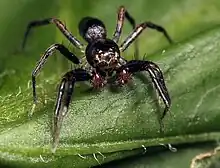Asemonea serrata
Asemonea serrata is a species of jumping spider in the genus Asemonea that is endemic to Kenya. The spider was first defined in 2001 by Wanda Wesołowska, one of over 500 that the arachnologist described during her career. The spider is small, with a yellow-orange carapace typically 2.5 mm (0.098 in) long and an yellow abdomen typically 2.5 mm (0.098 in) long. The abdomen has a black arrow-shape on it. The male is distinguished from other Asemonea species by the serrated edge on its the long and thin femoral apophysis. This is also recalled in the species name. The female has not been described.
| Asemonea serrata | |
|---|---|
 | |
| A spider of the Asemonea genus | |
| Scientific classification | |
| Domain: | Eukaryota |
| Kingdom: | Animalia |
| Phylum: | Arthropoda |
| Subphylum: | Chelicerata |
| Class: | Arachnida |
| Order: | Araneae |
| Infraorder: | Araneomorphae |
| Family: | Salticidae |
| Genus: | Asemonea |
| Species: | A. serrata |
| Binomial name | |
| Asemonea serrata Wesołowska, 2001 | |
Taxonomy
Asemonea serrata is a jumping spider that was first described by the Polish arachnologist Wanda Wesołowska in 2001, one of over 500 species she identified during her career.[1][2] She allocated the species to the genus Asemonea, first raised by Octavius Pickard-Cambridge in 1869.[3] The genus is related to Lyssomanes.[4] Molecular analysis demonstrates that the genus is similar to Goleba and Pandisus.[5] In Wayne Maddison's 2015 study of spider phylogenetic classification, the genus Asemonea was the type genus for the subfamily Asemoneinae.[6] A year later, in 2016, Jerzy Prószyński named it as the type genus for the Asemoneines group of genera, which was also named after the genus.[7] The species itself has a name that is derived from the Latin for saw-toothed and relates to the shape of the femoral apophysis.[8]
Description
The spider is small. The male has a moderately high rounded carapace that is typically 2.5 mm (0.098 in) long and 1.7 mm (0.067 in) wide. It is yellow-orange with a pale yellow eye field. The eyes are surrounded by black areas. Typically for the genus, the eyes arranged in two rows. It has a whitish clypeus. The chelicerae are orange, with two small teeth visible at the front and three small ones at the back. The abdomen is narrower than the carapace, typically 2.5 mm (0.098 in) long and 1.2 mm (0.047 in) wide. The topside is yellow with a black arrow-shaped patch towards the middle and two narrow brown stripes towards the front. The underside is whitish. It has light long spinnerets and yellow legs. The pedipalps are light brown. The palpal femur has a large furrow on the top surface. The dorsal tibial apophysis has three sharp tips.
The long and thin femoral apophysis has a serrated edge, after which the species is named. It is otherwise very similar to other species in the genus, particularly Asemonea maculata.[9] The female has not been described.[1]
Behaviour
The spider is typical of the genus.[10] Asemonea spiders rarely jump. Instead, they generally walk and run. They spin sheet webs on the underside of leaves, where they also lay their eggs.[11] Although predominantly a diurnal hunter, the spider is also likely to eat nectar.[12][13]
Distribution and habitat
The species is endemic to Kenya.[1] The holotype was found on Mount Elgon in 1938 at an altitude of {2,275 m (7,464 ft) above sea level. It lives in vegetation of the Podocarpus genus.[14] It thrives in mountainous areas.[15]
References
Citations
- World Spider Catalog (2017). "Asemonea serrata Wesolowska, 2001". World Spider Catalog. 18.0. Bern: Natural History Museum. Retrieved 13 May 2017.
- Wiśniewski 2020, p. 6.
- Wesołowska 2001, p. 577.
- Jackson 1990, p. 1.
- Maddison 2015, p. 236.
- Maddison 2015, p. 235.
- Prószyński 2017, p. 122.
- Wesołowska 2001, p. 584.
- Wesołowska 2001, p. 583–584.
- Wesołowska 2001, p. 583.
- Jackson 1990, p. 2.
- Richman & Jackson 1992, p. 33.
- Jackson et al. 2001, p. 28.
- Wesołowska 2001, p. 582.
- Dawidowicz & Wesołowska 2016, p. 464.
Bibliography
- Dawidowicz, Angelika; Wesołowska, Wanda (2016). "Jumping Spiders (Araneae: Salticidae) of Kenya Collected by Åke Holm". Annales Zoologici. 66 (3): 437–466. doi:10.3161/00034541ANZ2016.66.3.010. S2CID 89556915.
- Jackson, Robert R. (1990). "Comparative study of lyssomanine jumping spiders (Araneae: Salticidae): Silk use and predatory behaviour of Asemonea, Goleba, Lyssomanes, and Onomastus". New Zealand Journal of Zoology. 17 (1): 1–6. doi:10.1080/03014223.1990.1042257.
- Jackson, Robert R.; Pollard, Simon D.; Nelson, Ximena J.; Edwards, G. B.; Barrion, Alberto T. (2001). "Jumping spiders (Araneae: Salticidae) that feed on nectar". Journal of Zoology. 255 (1): 25–29. doi:10.1017/S095283690100108X.
- Maddison, Wayne P. (2015). "A phylogenetic classification of jumping spiders (Araneae: Salticidae)". The Journal of Arachnology. 43 (3): 231–292. doi:10.1636/arac-43-03-231-292. S2CID 85680279.
- Maddison, Wayne P.; Hedin, Marshal C. (2003). "Jumping spider phylogeny (Araneae: Salticidae)". Invertebrate Systematics. 17 (4): 529–549. doi:10.1071/IS02044.
- Prószyński, Jerzy (2017). "Pragmatic classification of the World's Salticidae (Araneae)". Ecologica Montenegrina. 12: 1–133. doi:10.37828/em.2017.12.1.
- Richman, David B.; Jackson, Robert R. (1992). "A review of the ethology of jumping spiders (Araneae, Salticidae)". Bulletin of the British Arachnology Society. 9 (2): 33–37.
- Wesołowska, Wanda (2001). "New and rare species of the genus Asemonea O. P.-Cambridge, 1869 from Kenya (Araneae: Salticidae)" (PDF). Genus. 12: 577–584. Retrieved 13 May 2017.
- Wiśniewski, Konrad (2020). "Over 40 years with jumping spiders: on the 70th birthday of Wanda Wesołowska". Zootaxa. 4899 (1): 5–14. doi:10.11646/zootaxa.4899.1.3. PMID 33756825. S2CID 232337200.